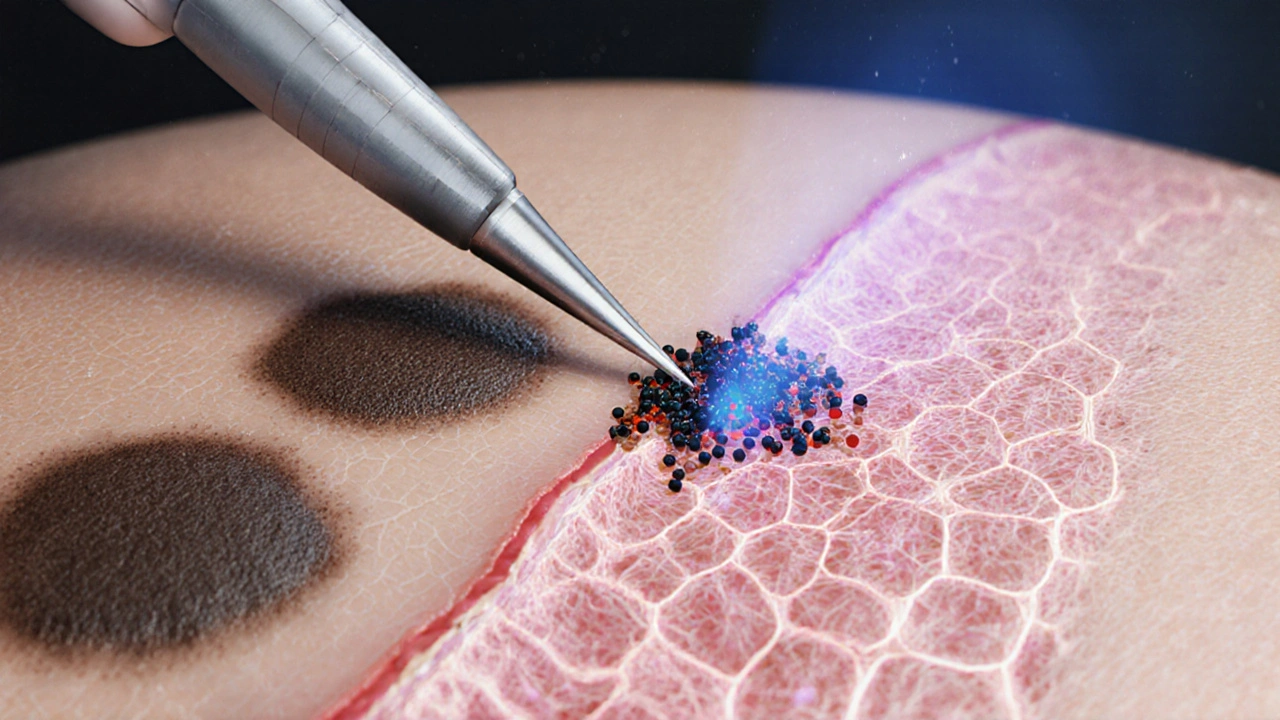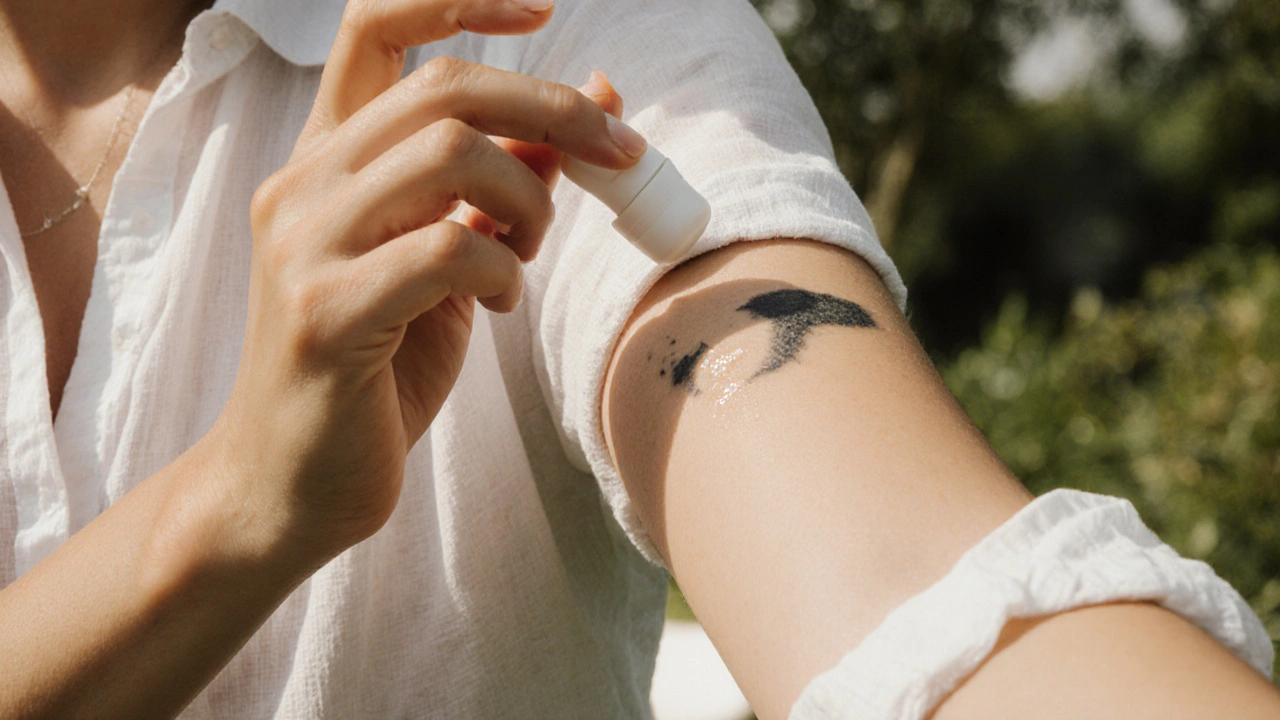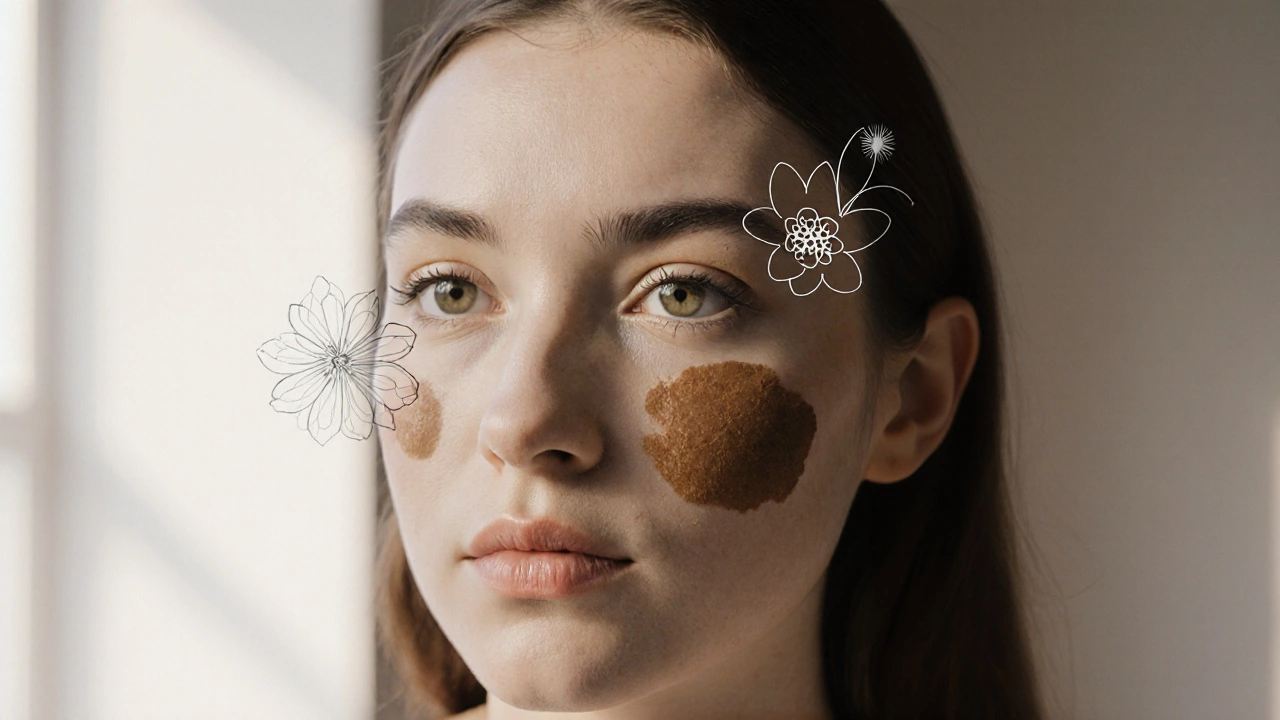Chloasma Tattoo Ink Suitability Calculator
Tattoo Safety Assessment
Result Summary
Thinking about a fresh piece of art on skin that already has chloasma tattoos in mind? You’re not alone. Many folks with chloasma wonder if a tattoo will brighten their look or ruin the skin’s tone. This guide breaks down what chloasma really is, how tattoo ink works with pigmented skin, and the steps you can take so the experience stays safe and looks great.
Key Takeaways
- Chloasma (melasma) is a hormone‑driven hyperpigmentation that reacts strongly to UV light.
- Ink pigments can either hide or highlight existing dark patches, depending on color and placement.
- Sun protection before, during, and after tattooing is the single most important preventive step.
- Choose a licensed artist who knows how to work with pigmented skin and can adjust needle depth.
- Monitor healing closely; any sudden darkening, itching, or swelling warrants a dermatologist’s review.
What Is Chloasma?
Chloasma is a chronic skin condition that appears as brown‑gray patches, usually on the cheeks, nose, forehead, or upper lip. Hormonal shifts-think pregnancy, birth control, or thyroid changes-trigger melanin overproduction, while UV exposure amplifies the spots. Unlike a regular freckle, chloasma can darken or fade with the seasons, and it often resists over‑the‑counter fading creams.
Key attributes of chloasma include:
- Age of onset: typically 20‑40 years
- Common triggers: sun, hormonal meds, stress
- Typical duration: months to years, sometimes lifelong
How Tattoos Interact With Pigmented Skin
When a needle punctures the dermis, it deposits pigment particles that sit alongside your own melanin. The interaction depends on three main factors:
- Ink color - Dark inks (black, deep brown) can mask the brown‑gray of chloasma, while bright colors may contrast sharply.
- Needle depth - Going too deep can cause scar tissue, which may alter the way melanin looks around the tattoo.
- Skin healing response - Some people experience post‑inflammatory hyperpigmentation (PIH) after the trauma of tattooing, which can worsen existing chloasma.
In short, tattooing doesn’t cure chloasma, but a skilled artist can design a piece that works with the natural pattern of your skin.

Risks and Potential Complications
Below are the most common issues people with chloasma face when getting inked:
- Exacerbated darkening - UV light during healing can intensify existing patches.
- Post‑inflammatory hyperpigmentation (PIH) - The body’s inflammatory response may leave new dark spots around the tattoo.
- Allergic reaction to pigments - Certain colors, especially reds and yellows, have higher allergy rates.
- Uneven fading - Over time, both the tattoo and chloasma may fade at different rates, causing a patchy look.
Understanding these risks helps you decide whether to proceed, and if you do, how to mitigate them.
Pre‑Tattoo Checklist for Anyone with Chloasma
Use this step‑by‑step list before you book the seat at the studio:
- Consult a dermatologist. Ask about your current chloasma activity and whether any topical treatments (e.g., hydroquinone, azelaic acid) are safe before tattooing.
- Patch‑test the ink. Ask the artist to do a tiny spot test on a non‑affected area. Wait 48 hours for any reaction.
- Schedule the session during low UV months. Autumn or winter reduces sun‑induced darkening during the healing period.
- Apply broad‑spectrum SPF 50+ for at least two weeks before the appointment, even on cloudy days.
- Hydrate your skin. A daily moisturizer with ceramides improves barrier function, leading to smoother healing.
Choosing the Right Ink and Artist
Not all tattoo studios are equal when it comes to pigment quality. Look for artists who:
- Use organic or low‑allergy pigments (e.g., vegan‑based inks) rather than metallic compounds.
- Can adjust the needle depth based on your skin type.
- Offer a portfolio that includes work on clients with hyperpigmentation or similar skin concerns.
Below is a quick comparison of common ink colors and their typical UV reactivity for chloasma‑prone skin.
| Ink Color | UV Reactivity | Risk Level for Chloasma |
|---|---|---|
| Black | Low | Moderate - masks patches but can cause PIH if depth is too deep |
| Brown | Low | Low - blends with natural melanin, good for camouflage |
| Red | High | High - higher allergy potential, may accentuate darkening |
| Yellow/Gold | Very High | High - metal compounds can trigger reactions, UV‑sensitive |
| Blue/Green | Medium | Moderate - decent contrast, but still need careful aftercare |

Aftercare: Protecting Your Skin While It Heals
The first two weeks are critical. Follow these guidelines to keep chloasma from getting worse:
- Keep the area clean. Gently wash with a fragrance‑free antimicrobial soap twice a day.
- Apply a thin layer of petrolatum (e.g., Vaseline) for the first 24‑48hours, then switch to a fragrance‑free moisturizer.
- Never expose the fresh tattoo to direct sunlight. Cover with loose clothing or a UV‑blocking bandage.
- Resume SPF 50+ after the scab falls off. Look for zinc oxide formulas, which are less likely to irritate fresh skin.
- Avoid swimming, hot tubs, and heavy sweating for at least three weeks.
If you notice any new dark spots, intense itching, or swelling beyond normal healing, schedule an appointment with a dermatologist promptly.
When to Seek Professional Advice
Even with perfect preparation, complications can arise. Contact a skin specialist if you experience:
- Rapid spreading of dark patches beyond the tattoo border.
- Persistent redness or pus that lasts more than five days.
- Signs of an allergic reaction: itching, hives, or swelling.
- Changes in the texture of the skin, such as thickening or scar formation.
Early intervention can prevent permanent discoloration and ensure the tattoo looks as intended.
Frequently Asked Questions
Can I get a tattoo directly over a chloasma patch?
Yes, but it’s safer to place the design on the edge of the patch rather than the center. This reduces the chance of the tattoo’s pigment reacting with the already‑hyperpigmented area.
Will a black tattoo make my chloasma look lighter?
Black ink can camouflage the brown‑gray tones, creating a visual illusion of lighter skin. However, it won’t change the underlying melanin production.
Is laser removal an option for a tattoo on chloasma‑affected skin?
Laser removal can work, but it may also trigger further hyperpigmentation. Choose a dermatologist experienced with melasma and request a test spot first.
How long should I wait after a chloasma flare before getting tattooed?
Wait until the flare has settled for at least 3‑4weeks. This gives the skin time to stabilize and reduces the risk of PIH.
Are there any topical treatments I should stop before tattooing?
Retinoids, glycolic acid, and strong hydroquinone formulas can make the skin more sensitive. Pause them 5‑7days before your session, unless your dermatologist advises otherwise.
Getting ink when you have chloasma isn’t a no‑go, but it does require extra planning. By understanding the condition, choosing the right artist, protecting your skin from UV, and watching the healing process, you can enjoy a tattoo that complements rather than compromises your complexion.



16 Comments
Harshal Sanghavi
October 12, 2025 AT 17:38Just make sure you test the ink before you go full pelt.
Duke Gavrilovic
October 13, 2025 AT 00:36Patch‑testing is a must, especially with chloasma‑prone skin. A tiny dot on a non‑affected area lets you see any redness or swelling before the real session. Keep the spot covered and watch it for 48 hours. If nothing weird shows up, you’re probably good to go.
Abby VanSickle
October 13, 2025 AT 04:46Even a tiny reaction can signal a bigger allergy down the line, so don’t ignore it.
chris macdaddy
October 13, 2025 AT 13:06Getting a tattoo when you have chloasma is a balancing act between artistic ambition and dermatological caution. First, you need to know that the melanin that causes those brown‑gray patches is highly reactive to UV light, and the tattoo process itself can trigger inflammation that darkens the area further. Choose an artist who knows how to adjust needle depth; too deep can create scar tissue that alters how pigment sits alongside your natural melanin. Opt for low‑allergy, organic inks whenever possible, because metals in some pigments, especially reds and yellows, are notorious for causing hypersensitivity. A patch test on a neutral skin spot is non‑negotiable; you should wait at least two days and monitor for itching, swelling, or color change. Schedule the appointment during a season with lower sun exposure-autumn or winter are ideal-to minimize UV‑induced darkening during the critical healing window. Apply a broad‑spectrum SPF 50+ for at least two weeks before the session, and continue diligent sun protection for the full healing period. Moisturize regularly with a fragrance‑free, ceramide‑rich lotion to keep the barrier intact and promote even healing. When the tattoo is fresh, keep it covered with loose clothing or a UV‑blocking bandage and avoid direct sunlight at all costs. After the scab falls off, switch to a zinc‑oxide based sunscreen, which is less likely to irritate the delicate new skin. Stay away from pools, hot tubs, and excessive sweating for at least three weeks, as moisture can introduce bacteria and disrupt pigment retention. If you notice any new dark spots, persistent redness, or unusual swelling, book an appointment with a dermatologist immediately. Remember that post‑inflammatory hyperpigmentation can still occur even with perfect technique, so be prepared for a possible need for topical lightening agents later on. Over time, both the tattoo and the underlying chloasma may fade at different rates, so plan for touch‑ups if you want the design to stay cohesive. By respecting these steps, you can achieve a piece that complements your skin rather than exacerbates the condition.
Moumita Bhaumik
October 13, 2025 AT 18:40They don’t tell you that the ink manufacturers hide metal additives that make chloasma worse.
Sheila Hood
October 14, 2025 AT 03:00Oh sure, because nothing says “careful planning” like trusting a needle to play nice with hormonal skin. If you love surprise hyperpigmentation, go ahead and pick the brightest red. Otherwise, stick with brown and keep the drama to a minimum.
Melissa Jansson
October 14, 2025 AT 08:33Brown does blend better, but even that can react if the artist is careless.
Max Rogers
October 14, 2025 AT 16:53Good points all around. I’d add that reviewing the artist’s portfolio for work on hyperpigmented skin is a smart move. Also, keep your after‑care routine consistent for at least four weeks. Lastly, don’t forget to hydrate from the inside out.
Louie Hadley
October 15, 2025 AT 01:13I’ve seen both successes and failures, so my take is to weigh the aesthetic benefit against the potential for PIH. If the design really matters to you, follow the preventive steps strictly. If you’re unsure, a temporary cosmetic tattoo could be a test run. Either way, listen to your skin’s signals.
Ginny Gladish
October 15, 2025 AT 09:33UV protection remains the single most critical factor during tattoo healing.
Faye Bormann
October 15, 2025 AT 17:53Honestly, the whole tattoo‑on‑chloasma conversation feels like a micro‑lab experiment that many of us run on our own bodies. You start with the excitement of a new piece, then you dive into research, patch tests, sunscreen regimens, and endless “what‑ifs.” The key is not to get overwhelmed by the checklist; treat it as a roadmap, not a stop‑sign. When you finally sit in the chair, ask the artist about their experience with hyperpigmented clients-knowledge matters. During healing, keep a journal of how your skin reacts; that data will help you decide on future touch‑ups. And if you ever notice a sudden darkening, don’t panic-consult a dermatologist before assuming the worst. Remember, tattoos are lifelong, but good skin health is priceless. So balance art with science, and you’ll likely come out looking and feeling great.
Kathy Butterfield
October 16, 2025 AT 02:13Love the thorough guide! 🙌 Keeps me from making a rash decision.
Zane Nelson
October 16, 2025 AT 10:33The article provides a commendable synthesis of dermatological considerations.
Sahithi Bhasyam
October 16, 2025 AT 18:53Wow!! sooo many details... i cant even!! but thx for the info!!
mike putty
October 17, 2025 AT 03:13Sounds doable with the right prep-go for it!
Kayla Reeves
October 17, 2025 AT 11:33We should prioritize skin health over aesthetic cravings.